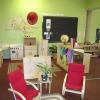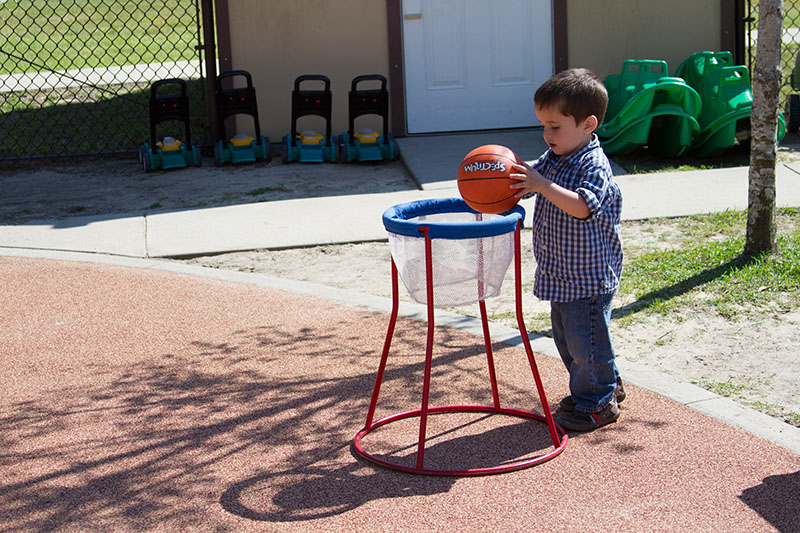- Describe the importance of outdoor play for infants and toddlers.
- Identify ways of creating safe and developmentally appropriate outdoor environments for infants and toddlers.
- Explore what infants and toddlers can learn in outdoor environments.
Learn
Know
The Importance of Outdoor Play
What do you remember from playing outdoors when you were younger? What are your favorite memories? What did you not enjoy?
Outdoor environments are the perfect space for infants and toddlers to explore, gather information, and experiment. Infants and toddlers are amazing young scientists who are capable, competent, and ready to learn using all of their senses!
The outdoor environment offers experiences that enable children to connect with nature. As Duncan, Martin, and Kreth (2016), write, “It is our definitive responsibility to diligently and continually cultivate children’s personal relationships with the land, which will sustain their energies, wonder, and memories for a lifetime” (p. 3). Being outdoors provides enjoyable experiences that are critical for infants’ and toddlers’ overall development. Outdoor environments support both large and fine motor skills, which strengthen children’s muscles, hearts, and lungs, and foster children’s health via strengthened immunity, more regular sleeping patterns, and an overall sense of well-being.
Creating an Outdoor Learning Environment
Outdoor learning environments should be designed with the same intentionality as indoor learning environments. They should inspire and motivate all learners, and must accommodate the needs of young infants, crawling infants, beginning walkers, and active climbers.
Incorporating elements from the indoor environment to the outdoors is essential. There are many ways in which this can be achieved. You can include the following areas:
- A calming space (swings, covered patios, cushioned seating, music)
- Dramatic play (pots, pans, riding toys, playhouse)
- Art (sidewalk chalk, paint brushes and water)
- Writing (clipboards with paper, writing utensils)
- Science, technology, engineering, math (STEM) (pipes, balls, ramps, plants)
- Sensory (water table, sprinkler, sand, dirt)
- Reading & Communication (books, conversations about nature, signs)
Infants are born with an innate curiosity. Infants and toddlers use their whole body to explore the environment around them and require constant supervision while outdoors. Infants and toddlers incorporate all of their senses into their learning, so it is necessary that all potential choking hazards be considered (they will often try to taste things they have discovered) and that caregivers remain in close proximity. Because infants and toddlers are still mastering balance, it is also important to offer a surface that allows them to move around easily and provides a soft landing. Surfaces that support infants, toddlers, and caregivers provide a level of comfort (for example, not too hot in the summer or too cold in the winter) and have enough space for children to move around without making contact with sharp edges.
Outdoor equipment should safely support the developmental needs of infants and toddlers. The Community Investment Collaborative for Kids Resource Guide (Pardee, Gillman, & Larson, 2005) recommends specific elements for infant and toddler outdoor spaces (p. 13):
- Places for eating or relaxing outdoors in the shade
- Convenient access to a diapering area and hand washing
- Safe spots for crawling, such as on grass
- A nonmetal slide with a gentle slope accessed by a low climbing ramp with steps and a handrail
- Bucket swings at a safe distance from other play
- Short tunnels and peek-a-boo places
- Comfortable seating at various levels
- Rocking toys that children can sit inside
- Pushing or riding wheeled toys
- Safe water and sand with simple props
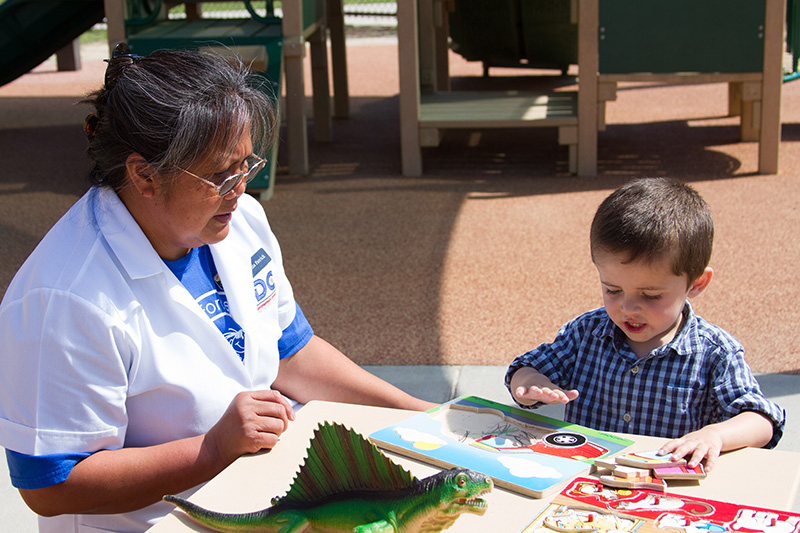
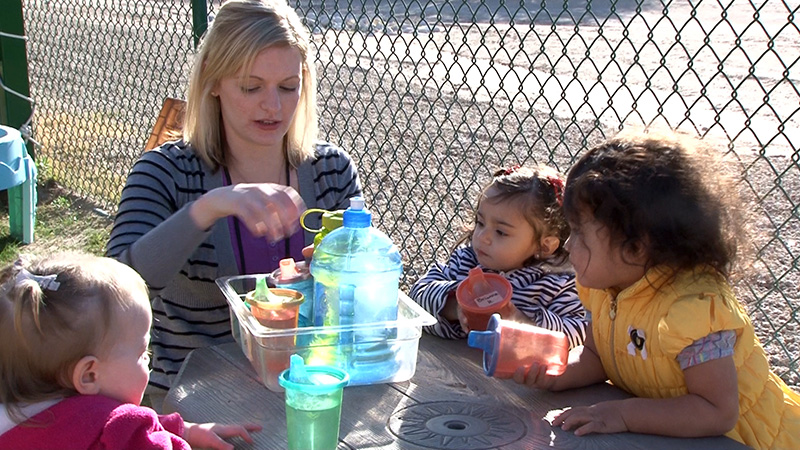
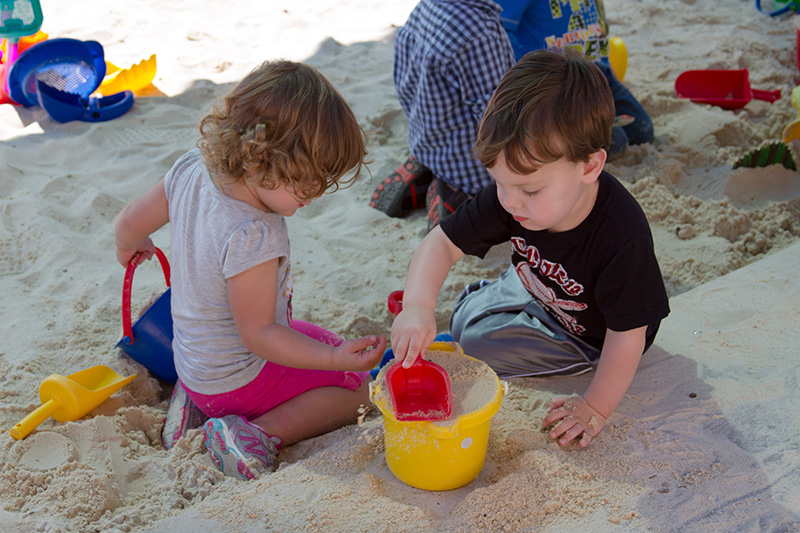
A safe outdoor learning environment for infants and toddlers is the result of emergent, informed planning and intentional design, developmentally appropriate equipment and activities, close supervision, a focus on engagement, and planned activities to support development and learning.
Follow your program’s safety guidelines to ensure all equipment complies with safety standards. Be sure to use the checklists from the Safe Environments course or your program to monitor and check the safety and security of your program’s outdoor learning environment.
Engagement and Learning in an Outdoor Learning Environment
The environment should be seen as the third teacher (Wurm, 2005). Infants and toddlers benefit from the outdoors—fresh air, sunshine, open space, exposure to nature, and early experiences with natural materials. They have opportunities to grow and learn, affecting all areas of development. Caregivers can support infants and toddlers by reflecting on the importance of outdoor experiences, asking open-ended questions, and planning ways to include these experiences in learning. Specifically, caregivers can ask themselves:
- As I observe infants and toddlers outdoors, do I notice differences in their attention and learning? What does this tell me?
- How do infants and toddlers experience the different spaces or areas we have designed outdoors?
- How does each infant and toddler develop while outside?
- In what ways do we create areas of inquiry, curiosity, challenge, wonderment, and movement for infants and toddlers? What ideas are emerging?
- How do we support their ideas with provocations?
Additionally, you should consider how to extend infant and toddler learning in the outdoor learning environment. Take note of the ideas, materials, and supports that are used indoors and think about how to meet developmental goals and encourage individual interests in your outdoor space. Pay particular attention to the language that you use. You can narrate children’s activities by saying things like, “I notice you are gathering sticks into a pile. I count 1, 2, 3, 4, 5. This pile is getting big. Tell me about your idea.”
Think about what open-ended ideas you can offer infants and toddlers in the outdoor learning environment. Incorporating these types of ideas enables children to have new experiences that might help them make connections or new discoveries. Duncan, Martin, and Kreth (2016), offer the following suggestions:
- Play in the dirt.
- Stomp in a puddle.
- Look for creatures under a rock or in the grass.
- Hold a dandelion and blow upon it.
- Look for a four-leaf clover.
- Toss autumn leaves in the air.
- Feel a tree’s bark, branches, and leaves.
- Gather interesting sticks from the ground.
- Collect pinecones.
- Bury your toes in mud.
- Walk barefoot in the early morning dew.
- Stomp in a puddle.
- Float a leaf on a puddle of water.
While children of all ages can enjoy the outdoor learning environment, caregivers should consider the various ages and developmental stages of the infants and toddlers in their care. This helps caregivers continue to meet the specific needs of infants and toddlers in each phase of development and provide intentional opportunities for them to actively use their senses as they explore the world.
Watch this video and notice how caregivers support the needs of children at different ages and developmental levels while offering different types of experiences and materials outdoors.
Outdoor Activities: Discovering and Exploring Together
Caregivers should also take time to understand what an outdoor learning environment means to families and try to identify strong beliefs, values, and perceived risks. Outdoor experiences can feel unsafe and cause uncertainty for some families. Other families may feel very strongly that being outdoors is an important part of their infant’s or toddler’s day and wish that they spent the majority of the day outdoors. When caregivers have knowledge of and sensitivity to what is important to families, they will be better equipped to create meaningful outdoor learning environments while providing supportive care for infants and toddlers.
See
Caregivers thoughtfully plan and organize for learning in outdoor environments just as they do indoor environments. Watch the video below. What do you notice about the outdoor environment that helps provide these infants and toddlers with a sense of security and opportunities for development and learning?
Learning Outdoors
Do
You can do many things to enhance and help infants and toddlers learn and feel comfortable in an outdoor environment. Consider:
- Using swings and benches to help create a comfortable area outdoors where you can hold, feed, or read to young infants.
- Creating opportunities to experiment with water using tubs, sprinklers, gutters, and sprayers.
- Pointing out interesting sounds and sights, such as a bird chirping.
- Growing nontoxic plants indoors and outdoors.
- Taking seeds from fruits served at lunchtime and planting them with toddlers.
- Lying on the grass and watching the clouds.
- Making an outdoor art center by adding easels, chalk, and paintbrushes.
- Creating different outdoor surfaces to jump and balance, such as beams, logs, and stumps.
- Adding a platform or playhouse to support pretend play.
- Talking to them about their outdoor experiences.
- Helping them make connections with nature.
Explore
Download and print the attachment, Outdoor Learning Environment: Vignette. Read, reflect, and answer the four questions and then share your responses with a trainer, coach, or administrator.
Apply
Think about your outdoor play spaces. Download and print the Outdoor Learning Environment Checklist or use a checklist provided by your administrator or program. Walk around your play space with a trainer, coach, or administrator while reviewing the list. Think about the strengths and needs of your space.
If you are a new staff member, you can use the Outdoor Learning Environment Plan to start thinking about the experiences, materials, and equipment you plan to provide in your outdoor learning space. When you are finished, discuss your plan with a trainer, coach, or administrator.
Glossary
Demonstrate
Children and Nature Network. (2020). https://www.childrenandnature.org/
Dodge, D., Rudick, S., & Berke, K. (2015). The creative curriculum for infants, toddlers, and twos (3rd ed.). Teaching Strategies, Inc.
Duncan, S., Martin, J. & Kreth, R. (2016). Rethinking the classroom landscape: Creating environments that connect young children, families, and communities. Gryphon House, Inc.
Early Head Start Early Childhood Learning & Knowledge Center. (2020). Resources for safe playgrounds. https://headstart.gov/facilities/article/resources-safe-playgrounds
Early Head Start Early Childhood Learning and Knowledge Center. (2021). Supporting outdoor play and exploration for infants and toddlers. https://headstart.gov/learning-environments/supporting-outdoor-play-exploration-infants-toddlers/supporting-outdoor-play-exploration-infants-toddlers
Greenman, J. (2005). Caring space, learning places: Children’s environments that work. Exchange Press Inc.
Greenman, J., Stonehouse, A., & Schweikert, G. (2008). Prime times: A handbook for excellence in infant and toddler programs (2nd ed.). Redleaf Press.
Pardee, M., Gillman, A., & Larson, C. (2005). Creating playgrounds for early childhood facilities (Community investment collaborative for kids resource guide 4). Local Initiatives Support Co.
Playground information to use with the environment rating scale. (2011). FPG Child Development Institute of the University of North Carolina at Chapel Hill. http://ers.fpg.unc.edu/sites/ers.fpg.unc.edu/files/playground%20revised%2010-28-10.pdf
Tinkergarten. (2019). Tinkergarten activities. https://tinkergarten.com/activities
Wurm, J.P., (2005). Working in the Reggio way: A beginner’s guide for American teachers. Redleaf Press.


